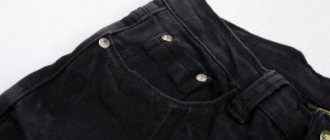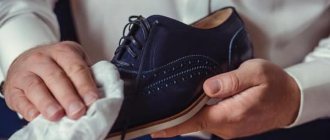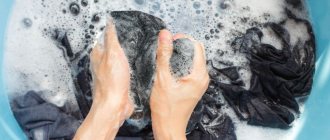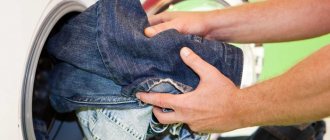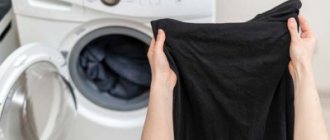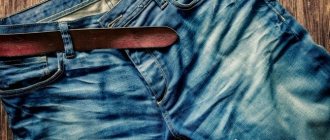Bleach is an excellent assistant for the housewife who carefully monitors the appearance of her clothes and tries to give them a flawless, sparkling look. However, if used inappropriately - for example, taken in a larger proportion than necessary, or accidentally splashed onto clothes that were not planned to be bleached, it can cause very big troubles.
The chemical compounds included in the product - hypochlorite, calcium hydroxide, chloride - corrode the color and destroy the structure of the fabric. It will be impossible to repair the damage by washing the item. Folk remedies are also powerless here. There is only one option to correct the situation: you will have to figure out how to disguise the white spot.
How and what to paint over a white spot on jeans
Bleach is an excellent assistant for the housewife who carefully monitors the appearance of her clothes and tries to give them a flawless, sparkling look.
However, if used inappropriately - for example, taken in a larger proportion than necessary, or accidentally splashed onto clothes that were not planned to be bleached, it can cause very big troubles. The chemical compounds included in the product - hypochlorite, calcium hydroxide, chloride - corrode the color and destroy the structure of the fabric. It will be impossible to repair the damage by washing the item. Folk remedies are also powerless here. There is only one option to correct the situation: you will have to figure out how to disguise the white spot.
What to do first?
The first thing to do when bleach gets on your clothes is to neutralize the effect of bleaching agents as soon as possible.
To do this, you need to carry out the following manipulations:
Thoroughly rinse traces of Whiteness on the fabric under running water. The goal is to rinse as much bleach out of the fibers as possible.
It is necessary to begin neutralizing traces of bleach as soon as the bleach gets on the clothes. Delaying the process significantly reduces the chances of removing stains and restoring the original appearance of the clothing.
"Ambulance"
Just to start with your favorite item, you need to provide “first aid”: stop the process of destroying the fabric by the bleach that gets on it. The stain must be thoroughly washed with cold running water. Just do not rub or wash it under any circumstances! Then treat with one of the substances:
- an aqueous solution of sodium thiosulfate (1 teaspoon per 1 glass of water); the drug is sold in pharmacies;
- baking soda mixed into a thick paste in cold water.
The product should be applied to the damaged area from the front and back. After 10 minutes, rinse thoroughly again under the tap. This will help remove any remaining chlorine from the fibers.
Citric acid for whitening jeans
In addition to bleaching jeans with white and hydrogen peroxide, you can use a natural substance. It will “gently” make jeans lighter without damaging the product, because natural-based acids have a minimal effect on the structure of fabric fibers. Therefore, a safe element for the required purpose is lemon juice, which is also used in the form of acid crystals.
For the required solution, add 15 tsp to a bucket of warm water. citric acid or 15 tbsp. concentrated juice. The resulting mixture is thoroughly mixed, where the trousers are immersed. The desired effect is not achieved immediately; jeans should be kept in “acidic” water for at least 5 hours, then rinsed thoroughly and dried.
From bleach
- You can color it over with a blue ballpoint pen or marker. It is important to choose the ones that best match the color of your jeans. First, the stain should be carefully sketched. Then take a damp gauze cloth and iron the treated area through it with a hot iron, first from the front side, then from the back. The jeans can then be washed.
Advice . It is best to save the pen or marker that has been used. After several washes you will have to use them again.
- It all depends on where the unwanted spot is located. It is quite possible that the patch will look very natural on him. Nowadays a huge variety of them is offered in stores selling sewing supplies.
- As an option - paint over the stain with special paint for denim or blue. Here it is important to strictly follow the instructions so as not to completely ruin the item.
- If the stain is too large, and even located in the most conspicuous place, in order not to throw the thing away, there is nothing left to do but repaint it a darker color.
- You can turn blue jeans into spotted “varenki”, which were super popular in youth fashion in the 90s of the last century. Or boil the trousers until completely white.
Important! When boiling, you will have to use bleach. It should be remembered that it is highly toxic. Inhaling its vapors for a long time is dangerous to health. Therefore, when performing procedures, the window in the room should be kept open and work only with rubber gloves.
You can use either liquid or powder bleach.
- First you need to put a large pan of water on the fire. Add bleach to it (the dose is 2-3 times more than for regular washing with bleach).
- Meanwhile, twist the jeans into a tight rope. The more small folds there are on them, the more interesting the resulting pattern will be. The shape of the tourniquet should be secured somehow, for example, by tying it with strong twine.
- When the water boils, the jeans need to be lowered into it. Cook, stirring with a long wooden stick.
- During the boiling process, it is important to carefully monitor how the denim changes color. When it reaches the expected saturation, the jeans need to be taken out immediately.
- Dumplings should be doused with cold water to cool slightly, then untied and rinsed well. Then wash as usual.
We fight various pollution
Jeans are universal, they can be worn both on weekdays and on holidays. Trips to nature, walks in the park, dates, workdays, friendly get-togethers and even parties are not complete without a pair of your favorite trousers.
It is in such an atmosphere that, through negligence, traces of a pleasantly spent time remain. How to remove a stain on jeans, knowing its origin and relatively short stay on the product? There are many ways, each will be effective in its own way.
Home Remedies for Cleaning Dirt
It’s easy to quickly remove a greasy stain at home; available products will help you in this matter.
- Newly planted crops are removed with salt. Sprinkle it on the dirt and leave it for a while. Thanks to its absorbent properties, the kitchen product will attract dirt onto itself. The owner will only have to carefully remove the powder with a paper napkin.
- You can remove dirt stains from jeans by simply washing them. The trousers are turned inside out and washed in a small amount of warm water without any detergent.
- Spilled coffee is afraid of egg yolks; this is the only way to clean it up. The egg yolk is mixed with a couple of drops of alcohol and a little warm water is added. Apply to the stain for a few minutes and wash off.
- Carbonated water with salt will remove coffee and traces of food; a teaspoon is enough for a glass of liquid. Mix well and rub in using a cotton pad or clean cloth.
- Starch will help get rid of greasy stains on jeans. The product is mixed with a small amount of water to form a paste and applied to the problem area. The treated product is left alone for a while, the product should be absorbed into the fabric, and then washed under the tap.
After each cleansing procedure, it is imperative to rinse the item of clothing and secure the result by washing it in the machine.
Household chemicals
Household chemicals can remove stains on jeans of various origins. The assistants will remove stains of varying complexity, will not spoil the structure of the fibers, and will preserve the color. Efficiency differs:
- dishwashing detergent, which is used to treat fresh traces of grease on clothes, is added to enhance the effect when washing particularly dirty wardrobe items;
- high-quality washing powder, used to make a paste that is applied to yellow stains on jeans;
- You can remove stains on jeans with a stain remover; you must do this carefully, observing the dosage;
- Laundry soap, the product is a universal stain remover for fabrics, can even get rid of old stains;
- Tooth powder will help get rid of the greasy mark on jeans; sprinkle it on the dirt and leave it for several hours;
- Shaving cream will help remove traces of cosmetics from trousers; it works well when foundation comes into contact with it;
- Hairspray will help get rid of food or drink stains, especially effective on white and light-colored clothing.
There are many ways to remove stains from jeans, the main thing is to use the substances correctly and rinse thoroughly.
Traditional methods of combating pollution
Stains from denim can be removed with many preparations; housewives have begun to notice the ability to remove stains of varying complexity and origin from many household substances that have nothing to do with washing.
- How to remove food marks on jeans? The absorbent will be chalk, its ability to absorb fat is comparable to the qualities of tooth powder, it acts in approximately the same way. Before application, the chalk is crushed to a powder state, the dirt is sprinkled on it and left for 3-6 hours, or overnight. Residues are removed with a paper napkin or a dry, clean cloth.
- How to display various traces? Ether and magnesium will remove oil on this type of fabric. The solution is prepared immediately before use; for this, both components are taken in equal quantities and mixed. Rub the product into the stain with a cotton pad and leave for 2-4 hours, rinse and wash as usual.
- How to remove marks of unknown origin from jeans if detergents do not help? A solution of alcohol and turpentine will remove such contamination without problems. For its preparation, equal parts of both components are used. The substances are mixed and applied to traces of dirt, left to soak for 3-5 hours, then washed.
- How to remove food stains from light-colored denim trousers in order to preserve the color and not spoil the item? Only with ammonia, traces of contamination are soaked in it, allowed to sit for 30-60 minutes and washed as usual.
- A solution of gasoline and acetone will be more aggressive, but also more effective in the question of how to remove food stains. First check the composition of the product; it should not contain synthetics, the solution will be harmful to it. Gasoline is bought in a specialized store, it must be purified, the liquid from the gas station will not get rid of contaminants, but will leave new ones. The components are mixed in equal quantities and the resulting solution is well soaked in traces of fat using a cotton swab. This must be done several times to increase efficiency. After a couple of hours, you can start washing the product.
- It’s easier to remove blood from jeans; just wet the contaminated area under running cold water or soak the item in a basin. After half an hour, change the water and rub the dirt a little. After the third water change, wash.
The suggested tips may not have the desired effect after the first procedure. If the marks show a tendency to disappear, then carry out the procedure again.
Clue
If you need to boil your jeans to a more or less uniform white color, you don’t need to twist them into a rope, just put them in boiling water with bleach. Monitor the cooking process very carefully, regularly turning the jeans in the pan with a wooden stick so that the water and bleach can flow into each fold.
Finally, the transition points between a darker shade and a lighter one can be rubbed with a stiff clothes brush to give the item an even more stylish, worn look.
If a yellow bleach stain has formed on your white jeans, you can also try to remove it by treating it with one of the following products:
- ordinary household stain remover;
- hydrogen peroxide;
- powdered acetylsalicylic acid tablets (pharmaceutical Aspirin), diluted to a thick paste with water;
- paste of baking soda and water.
After applying any of the above products to the damaged area, the item should be allowed to sit with it for 20-30 minutes. Then rinse and wash as usual. If necessary, repeat the procedure.
From the green grass
- Pour 70-90 degree alcohol (instead, you can use 9% clear vinegar, hydrogen peroxide, vodka) for half an hour. Then wash the item as usual.
- Cover with baking soda for 1-2 hours and moisten, then wash thoroughly.
- You can mix ammonia with hydrogen peroxide (1:1). This mixture will help to effectively clean off old green grass stains that have already ingrained into the fabric. But here you need to act very carefully: make sure that the jeans do not discolor. It is better to test the product first, for example, on the back of the waistband of jeans.
From blood
A fresh stain should be washed under running water as cold as possible. Then wash with laundry soap. This should be done as quickly as possible, since the protein quickly penetrates into the structure of the tissue and, once dried, it will be much more difficult to remove it from there.
An old stain will first have to be soaked in warm water for a couple of hours. Then use one of three methods to remove the blood stain.
- You can fill it with glycerin for 20 minutes, then wash it in cold water with powder or laundry soap.
- Dilute ammonia in water (1:1) and pour the solution onto the stain for half an hour. Wash by hand.
- Mix starch, baking soda and table salt (1:1:1), dilute the mixture to a thick paste with cold water. Apply the composition to the damaged area of the fabric. Launder.
It is recommended to test this composition first to see if it will harm the fabric by discoloring it. A small drop should be applied, for example, to the inside of a pocket.
Alternative solutions
If you like experiments, buying a dye and then applying it according to the instructions is too banal and boring. A number of alternative products will help you achieve the desired color and original effects.
Chlorine bleach
Peculiarities. “Varenki” are legendary jeans. More than one generation of fashionistas has strived to own this thing. The technology came to us from Japan. There, nodular staining has been elevated to the level of an art. If you want to show off in jeans with beautiful white streaks, you will have to work a little magic on the item.
Treatment
- Fill a metal bucket with water and add a cup of chlorine bleach.
- Crumple the jeans into a ball or twist them and tie them tightly with string to secure the shape.
- Immerse the item in the liquid and place the bucket on the burner.
- Boil the jeans over medium heat for a quarter of an hour.
- Rinse the product thoroughly in cold water.
If you're not sure how to properly dye old jeans that are faded, try bleaching them completely for a stylish new look. The technology is the same as for making “varenok”, but there is no need to twist or tie the product.
Potassium permangantsovka
Peculiarities. Potassium permanganate is another means with which you can make fashionable “varenki”. This is a great way to partially dye jeans by hand without boiling or any other heat treatment.
Treatment
- Mix a heaping tablespoon of manganese with half a glass of vinegar and two tablespoons of peroxide.
- Dilute the resulting composition with water (3 l).
- Roll the jeans tightly and secure them with ropes or elastic bands.
- Place the product in the solution for 20 minutes.
- Rinse your jeans several times in cold water and wash them with powder.
Zelenka
Peculiarities. If you want to dye your jeans green, the ideal solution is brilliant green. With some simple manipulations you can turn it into an excellent dye for clothes.
Treatment
- If you want to dye your white jeans, just wash and iron them. If the product is of a different color, it must first be kept white.
- Dissolve the contents of a standard bottle of brilliant green in 5 liters of water.
- Soak wet jeans in the solution for half an hour.
- Rinse the product in cold water and soak in water and vinegar for a quarter of an hour.
Hair dye
Peculiarities. Hair dye is one of the alternative means for dyeing jeans. It gives the fabric a rich shade and holds up well. As a rule, it is used to dye thick regular or corduroy jeans.
Treatment
- Pour warm water into a basin or bucket and add paint of the chosen shade. If you use toner, you will need two bottles for the brightness of the color.
- Immerse washed and dried jeans completely in the solution for one and a half to two hours.
- To remove any remaining dye, rinse the item several times. Alternate warm and cold water.
- Pour water into the container. For each liter, add two tablespoons of vinegar and one spoon of salt. Leave the item in the composition for 15 minutes.
- Wash the product in powder and hang it to dry away from sunlight and heating devices.
If you want to refresh the black color of your jeans, use basma. This is a natural dye that will not harm either the skin or the fabric.
From fuel oil, machine oil
The following products will help you deal effectively with these stains.
- Toothpaste. It should be applied to the stain and left until it dries completely. Then wash it. You need to be careful not to use toothpastes with a whitening effect - these can discolor the denim.
- Chalk. It needs to be crushed into powder and poured thickly onto the area of contamination. Leave overnight. By morning the stain should disappear forever.
- Dishwashing gel . It perfectly dissolves fat-containing substances. The gel does not need to be diluted in water the day before application. After 15 minutes, the jeans can be rinsed from the gel and washed in the machine as usual.
- Gasoline and kerosene. Apply one of these products to a cotton swab and rub the stain with it. Just be careful not to press too hard to avoid damaging the fabric structure. Wash as usual.
From rust
Rust stains can appear not only because the owner of the jeans gets into it somewhere. Over time, rust can form on the fabric around metal rivets or buttons. The reason for this is numerous washes. In these places it is not very noticeable, but the very fact of the presence of stains is unpleasant. To remove rust, it must be dissolved in acid. For example, in lemon (3-4 grains per 1 tablespoon of water) or in natural freshly squeezed lemon juice. You can use an aqueous solution of 7-9% clear table vinegar.
One of the products should be applied to the fabric, wet it thoroughly, then iron the area with a hot iron through a gauze cloth, first from the front side, then from the back. After this, wash the jeans by hand with soap and warm water.
Source
Small specks
To paint over small spots, for example, from whiteness, it is enough to use ordinary stationery. To do this, select a marker, felt-tip pen or colored pencil according to color. Carefully sketch out the spot (you will have to remember coloring books from childhood). Turn the item inside out and cover with a piece of damp gauze. After this, go through the iron. If the denim is black, try applying liquid eyeliner or mascara.
The main reasons for changing the color of jeans
Stains and white spots on black jeans appear for the following reasons:
- frequent washing, during which the paint is washed out;
- cleaning in the washing machine, in which jeans become wrinkled;
- non-compliance with rinsing rules, which is why powder particles remain in black jeans;
- wash in cold or hot water;
- natural shedding of jeans;
- sunburn;
- use of chlorine-containing products during cleaning.
It is not recommended to soak black jeans. But if this is necessary (for example, to remove difficult stains), then a solution of salt and powder should be added to the water.
The many faces of denim
Denim clothing, especially jeans, is striking in its variety of shapes, sizes and materials. This may not surprise fashion fans, but many people will be amazed at how these clothes can change the look and style, will gain a new appreciation for denim and will enjoy wearing it even more. Denim fabric - stretchy, washed or dyed without water washing - has different properties and even looks different. We bring to your attention a brief overview and recommendations for removing stains.
Different styles
A wide variety of clothes are made from denim - leggings, flared trousers and even overalls - which occupy a strong place in the wardrobe of almost every person. Jeans - simple straight cut, flared from the knee or tight - are a true legend of style and fashion. Perhaps now, when you read these lines, you are wearing jeans.
Denim dyed without water washing
The name of this fabric - denim dyed without washing in water - speaks for itself. During the manufacturing process, this fabric is not washed after dyeing. This means that it will lose its color over time, and many people actually like it that way. This typically occurs in areas that receive the most wear and tear, particularly the knees.
"Washed" denim
Most denim fabrics are classified as “washed”. This treatment makes the fabric softer, but may still look worn even before wearing. It may seem like you are dressed in rags.
Selvage denim
Selvage denim is a truly unique product of light industry. This fabric is made using sophisticated continuous weaving technology and is highly durable and wear-resistant.
Stretch denim
Stretch denim contains not only cotton, but also elastic components that cause the jeans to shrink, but at the same time fit snugly around the legs. Of course, the more clothes stretch, the less they will last you.
Denim clothing, especially jeans, is striking in its variety of shapes, sizes and materials. This may not surprise fashion fans, but many people will be amazed at how these clothes can change the look and style, will gain a new appreciation for denim and will enjoy wearing it even more. Denim fabric - stretchy, washed or dyed without water washing - has different properties and even looks different. We bring to your attention a brief overview and recommendations for removing stains.
Different styles
A wide variety of clothes are made from denim - leggings, flared trousers and even overalls - which occupy a strong place in the wardrobe of almost every person. Jeans - simple straight cut, flared from the knee or tight - are a true legend of style and fashion. Perhaps now, when you read these lines, you are wearing jeans.
Denim dyed without water washing
The name of this fabric - denim dyed without washing in water - speaks for itself. During the manufacturing process, this fabric is not washed after dyeing. This means that it will lose its color over time, and many people actually like it that way. This typically occurs in areas that receive the most wear and tear, particularly the knees.
"Washed" denim
Most denim fabrics are classified as “washed”. This treatment makes the fabric softer, but may still look worn even before wearing. It may seem like you are dressed in rags.
Selvage denim
Selvage denim is a truly unique product of light industry. This fabric is made using sophisticated continuous weaving technology and is highly durable and wear-resistant.
Stretch denim
Stretch denim contains not only cotton, but also elastic components that cause the jeans to shrink, but at the same time fit snugly around the legs. Of course, the more clothes stretch, the less they will last you.
Stains on denim fabric
Despite the variety of denim fabrics, Vanish can easily tackle most stains that commonly appear on clothing, including oil and coffee stains. As a rule, the stain remover is selected taking into account the nature of the stain, but in many situations it is enough to use Vanish Gold Oxi Action powder.
Rules for washing black jeans
Regardless of the chosen method of cleaning jeans, to prevent them from losing color, you must adhere to the following recommendations:
- Before washing, turn pants inside out;
- adhere to the manufacturer’s recommendations regarding water temperature (optimally - no more than 40 degrees) and other washing conditions;
- wash black jeans in a washing machine using a gel product and conditioner that preserves the color;
- Do not soak in water for a long time.
However, even if you wash your jeans correctly, white streaks will appear on the material over time. Special paint helps remove such defects.
In the washing machine
When using a washing machine to clean black jeans, you should follow several recommendations:
- fasten zippers and buttons;
- remove foreign objects from pockets;
- set delicate mode;
- rinse the product;
- do not turn on the spin program.
Useful tips
Removing stains, especially old ones, is always labor-intensive, so as not to use aggressive agents and reduce treatment time, follow these rules:
- Try not to leave the removal of contaminants of various origins until later; remove them as soon as possible.
- Use fresh products.
- Prepare solutions of several components before use, discard the remainder.
- Carefully read the instructions for using the stain remover.
- Do not over apply stain removers.
- Only wash your jeans after you have removed the stain. Don't add other things.
We found out how to remove a grease stain from jeans in the most effective way; everyone can choose the most suitable one on their own.
It's not difficult to remove stains, but it's better not to plant them. Take proper care of your wardrobe, remove dirt on time, and your clothes will last you a long time.
Source of the article: https://pravilauborki.ru/hlopoty/pyatna/kak-izbavitsya-ot-pyaten-na-dzhinsah.html
How to wash dirt from jeans? ServiceYard - the comfort of your home is in your hands, How to remove stubborn dirt from jeans.
Additional recommendations
In the latter case, the most gentle operating mode should be installed.
Cleaning black jeans with chemicals is prohibited. Due to aggressive influence, the product not only loses color, but also quickly wears out. It is also recommended to wash jeans with black items that have begun to fade. In this case, the white stripes may disappear, and the original color of the product will be fixed.
How to dry properly
Black jeans should not be wrung out after washing. To remove excess moisture, the product must be blotted with a towel. When drying your pants, you should follow several recommendations:
- hang it so that the trouser legs remain straight;
- Avoid exposing your trouser legs to direct sunlight;
- hang the product away from heat sources;
- To speed up drying, hang jeans in ventilated areas or in the open air.
The product should be dried by turning it inside out. You should not wear wet jeans, as dirt and dust will quickly settle on the fabric.
Fat removal methods
Most often, stains on clothes come from food, in particular stains from fatty foods. It is not easy to remove them, but it is possible; it is not necessary to make incredible efforts; it is enough to know some secrets of using certain household substances. Many have fat-breaking properties and will help save the situation in a matter of minutes.
Removing fresh stains
- How to quickly remove a greasy stain on jeans if it has just been stained? Use paper towels, place them under the dirt from the wrong side, and blot them on top. The procedure is carried out until the fabric gives off fat; washing in this case cannot be avoided, but it can not be done immediately.
- The trace is pre-processed. They use talc or baby powder, they will simply pull the fat onto themselves, just carefully remove the resulting grains and add new portions of the substance.
- Potato starch can quickly cope with contamination, but washing after its use is inevitable. The procedure is identical to the previous one.
- An artificial sweetener will help remove traces of oil from a wardrobe item. It is applied to the mark and left for 15-20 minutes. This is a relatively quick way to remove stains from jeans.
- How can you remove fat from this type of clothing? For severe contamination, use white spirit, but this must be done carefully so as not to permanently damage the product.
An instant reaction to contamination will help remove it without leaving a trace; if removal is delayed, you will have to use aggressive substances.
Old stains
How to remove yellow stains from jeans? Here you will need more time and patience, as greasy stains that are not removed in time acquire this color. There are several methods, each of them may require repeated application.
- How to remove old fat from jeans? What will help get rid of such pollution? White wine vinegar will retain color and remove oil from jeans. Apply the substance to a paper towel or cotton pad, soak the marks, leave for 30-40 minutes, and wash in the machine with powder.
- Old oil on jeans will succumb to refined gasoline. It is rubbed into old marks and left for 2-4 hours, periodically wetting the stains. Washing is carried out several times using standard products.
- How to remove yellow marks from jeans? Try turpentine, it's aggressive but effective. Traces of contaminants are soaked in the substance and left for some time. After washing in the machine.
Products with old yellow marks can be dry cleaned, but the color of the material may also go away along with the stains. And the cost of the procedure will not be cheap.
